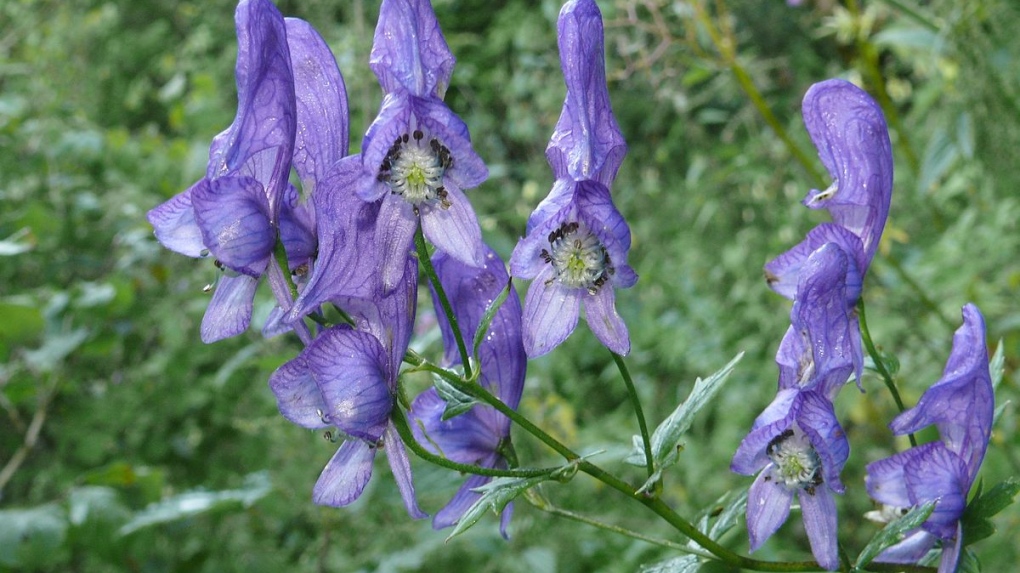What is aconite poisoning? Toronto doctors explain
As many as 12 people were forced to seek medical attention after ingesting what officials suspect to be aconite at a restaurant in Markham, Ont. over the weekend.
York Region’s Medical Officer of Health, Dr. Barry Pakes, spoke Tuesday morning on the mass poisoning, which took place at Delight Restaurant & BBQ at Castlemore Avenue and Markham Road.
While Pakes could not speak to the condition of the patients, he confirmed four remain “seriously ill” in intensive care units.
“We do suspect that it was … aconite,” Pakes said, adding that testing is currently underway to confirm the cause of the adverse reactions.
WHAT IS ACONITE?
Aconite is a substance found in Aconitum plants, also known as Monkshood or Wolfsbane, and can be found widely across the Northern Hemisphere, Dr. Prateek Lala, associate director of applied clinical pharmacology at the University of Toronto, told CTV News Toronto Tuesday.
All parts of the plant are toxic, he explained, but the compound aconitine is particularly deadly.
“The lethal dose for humans can be as little as two milligrams, or the size of a sesame seed,” Lala said.
 A plant in the Aconitum family can be seen above. (Wiki Commons)
A plant in the Aconitum family can be seen above. (Wiki Commons)
WHAT ARE THE SYMPTOMS OF ACONITE POISONING?
Symptoms can vary depending on how much is ingested and the size of the person who ingested it, Lala said.
“The symptoms that people feel after consuming usually start within 30 to 60 minutes, so a much shorter timeframe than you would see with typical food poisoning,” he said.
On Monday, Dr. David Juurlink, head of clinical pharmacology and toxicology at Sunnybrook Health Sciences Centre, took to social media to warn the public of the potential poisoning event, and what symptoms to watch for.
“Effects occur quickly and are chiefly [gastrointestinal] , neurologic and cardiac,” he wrote.
Juurlink warned the public to monitor for nausea, vomiting, cramping, numbness in the face and mouth area that could progress to the limbs, and muscle weakness.
Symptoms at the later stages of aconite poisoning can include low blood pressure, cardiac arrhythmias and coma. If enough is ingested, it can be fatal.
“It doesn't take a lot for this to have a significant effect,” Lala said.
HOW DO YOU TREAT ACONITE POISONING?
There is no one cure for aconite poisoning, both doctors said.
“Most of the therapies and treatments for this are supportive,” Lala explained. “There are medications that can be used to support heart rhythms and blood pressure and things like that, but for the most part, it's a game of watching and waiting to see how things progress.”
Some patients require ventilation to help support their breathing while they recover.
While there’s no standardized timeline, those who recover from the poisoning will do so in a matter of days, Lala said.
HOW COULD ACONITE END UP IN FOOD?
While raw aconite can be deadly, and risk remains high if ingested, Aconitum plants have been used in Traditional Chinese Medicine for thousands of years.
When used in Traditional Chinese Medicine, the toxins within acotinum plants can be decomposed into less or non-toxic derivatives using Chinese processing methods known as Pao Zhi.
Aconite can also sometimes be mistaken for ginger powder, as the roots of both plants are visually similar.
In March, a health authority in British Columbia issued a warning after a batch of sand ginger powder bought at a Burnaby mall was found to potentially have aconite in it.
Lala underlined that, at this time, there is no information available as to whether the incident in Markham was accidental or intentional.
Anyone who ate at Delight Restaurant and BBQ on Aug. 27 or 28 and is experiencing any of the symptoms listed above is being encouraged to seek immediate medical attention.
CTVNews.ca Top Stories

Trudeau noncommittal on expanding rebate beyond 'working Canadians'
Prime Minister Justin Trudeau does not appear willing to budge on his plan to send a $250 rebate to 'hardworking Canadians,' despite pressure from the opposition to give the money to seniors and people who are not able to work.
'Mayday!': New details emerge after Boeing plane makes emergency landing at Mirabel airport
New details suggest that there were communication issues between the pilots of a charter flight and the control tower at Montreal's Mirabel airport when a Boeing 737 made an emergency landing on Wednesday.
Cucumbers sold in Ontario, other provinces recalled over possible salmonella contamination
A U.S. company is recalling cucumbers sold in Ontario and other Canadian provinces due to possible salmonella contamination.
Latest updates: Tracking RSV, influenza, COVID-19 in Canada
As the country heads into the worst time of year for respiratory infections, the Canadian respiratory virus surveillance report tracks how prevalent certain viruses are each week and how the trends are changing week to week.
Weekend weather: Parts of Canada could see up to 50 centimetres of snow, wind chills of -40
Winter is less than a month away, but parts of Canada are already projected to see winter-like weather.
W5 Investigates A 'ticking time bomb': Inside Syria's toughest prison holding accused high-ranking ISIS members
In the last of a three-part investigation, W5's Avery Haines was given rare access to a Syrian prison, where thousands of accused high-ranking ISIS members are being held.
Federal government posts $13B deficit in first half of the fiscal year
The Finance Department says the federal deficit was $13 billion between April and September.
Armed men in speedboats make off with women and children when a migrants' dinghy deflates off Libya
Armed men in two speedboats took off with women and children after a rubber dinghy carrying some 112 migrants seeking to cross the Mediterranean Sea started deflating off Libya's coast, a humanitarian aid group said Friday.
Nick Cannon says he's seeking help for narcissistic personality disorder
Nick Cannon has spoken out about his recent diagnosis of narcissistic personality disorder, saying 'I need help.'

































